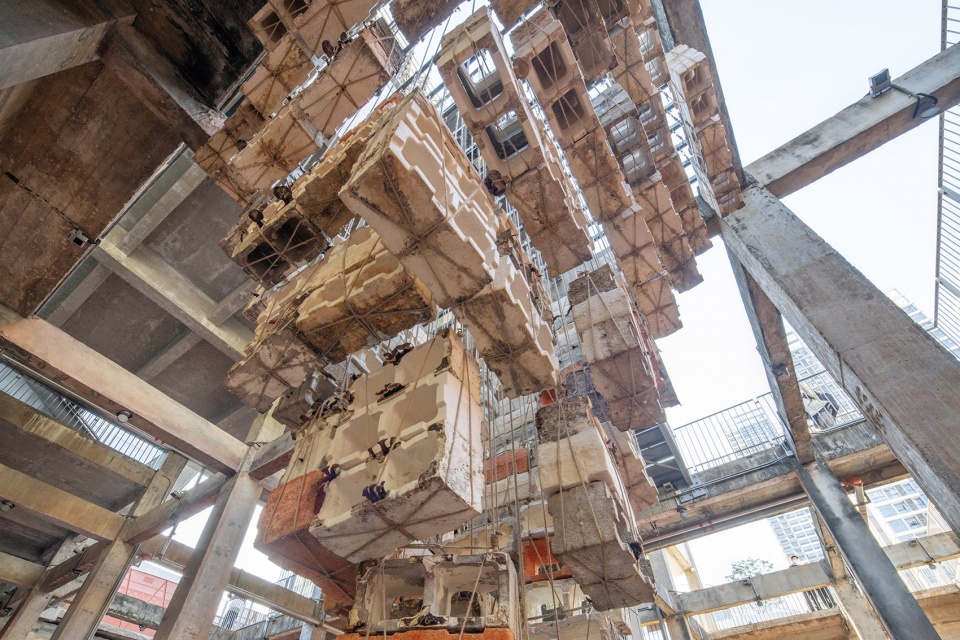

山、雾、房子
MOUNTAIN FOG,BUILDING
重庆多雾,南山更甚,其景观常年在视觉上处于不断的消解而重构之中,魔幻而令人沉迷。原址建筑位于南山山腰,是一个由三个不同时期的建造体量拼贴而成的“怪房子”,其内部体验亦是曲折幽闭,峰回路转。在此地,山,雾,房子三者共筑了某种含混而不可言说的场所精神,颇有一种“塔可夫斯基”式的电影体验。这一切都预示着常规改造手法已无法回应区域要素提供给人的所有感官知觉。
▼雾天南山,the southern mountain in fog ©止建筑

Chongqing is foggy, and the southern mountain is even more. Its landscape is constantly disintegrating and reconstructing visually all year round, which is magical and addictive. The original building is located on the mountainside of the southern mountain. It is a “weird house” composed of three different periods of construction. Its internal experience is also tortuous and claustrophobic, with twists and turns. Here, mountains, fog, and houses create a vague and unspeakable spirit of place, a kind of “Tarkovsky” movie experience. All of this indicates that conventional renovation methods have been unable to respond to all the sensory perceptions provided by regional elements.
▼原建筑外观,original state of the building ©止建筑

▼塔科夫斯基电影截图,screen shot of Tarkowski film ©网络图源
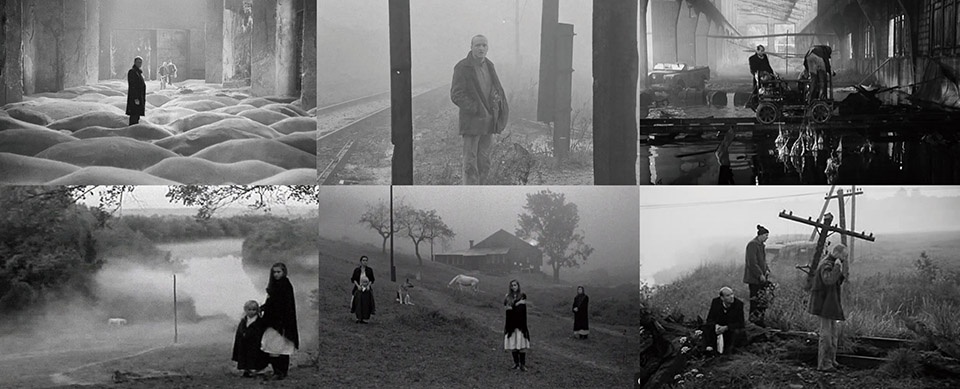
桥
BRIDGE
“含混和不可言并不意味着没有清晰的图像,这是一种由梦的逻辑产生特殊印象,是由完全现实的因素组合在一起并相互冲突造成的异常与意外。”
“Vague and ineffable does not mean that there are no clear images, it is a special impression produced by the logic of dreams, anomalies and surprises caused by the combination and conflict of perfectly realistic elements.”
—— 安德烈.塔科夫斯基,Andrei Tarkovsky
▼鸟瞰航拍图,aerial view of the project and surrounding environment ©止建筑
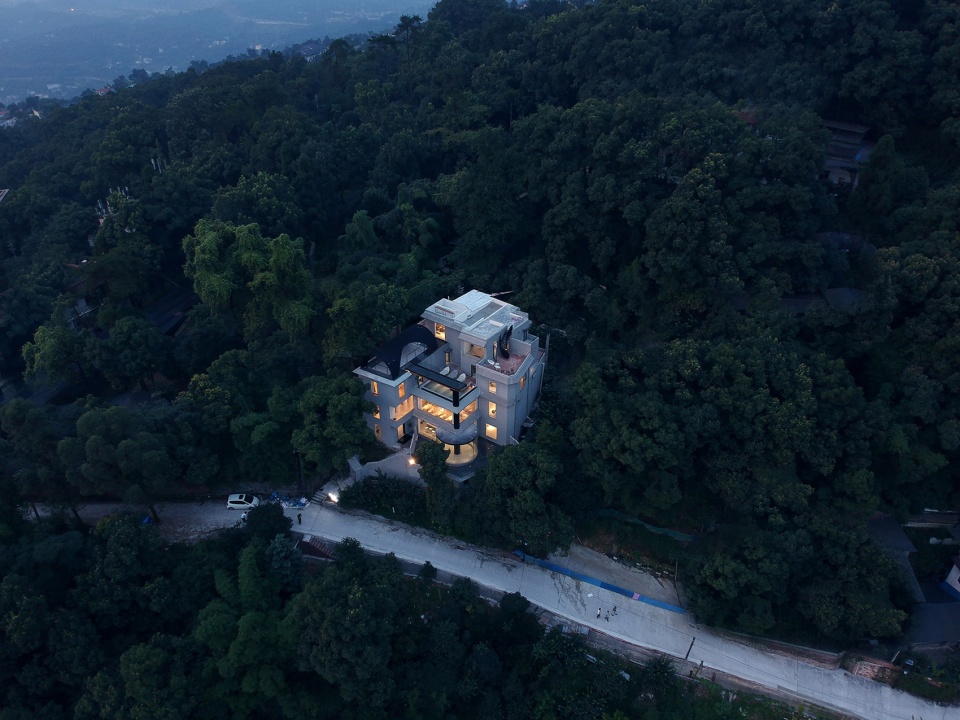
▼正立面航拍图,aerial view of the front facade ©止建筑

我们选择在雾中架起一座没有尽端的桥梁。“桥”是一个意味明确的构筑:在空间上,其指向一种架接性的通过行为;叙事上,则往往与“互视”“相遇”等“事件”相联系。其稳定而明确的符号性,与飘忽的景观在场共筑了某种奇妙的幻境式体验。
▼加建部分图解,analysis of the renovation part ©止建筑
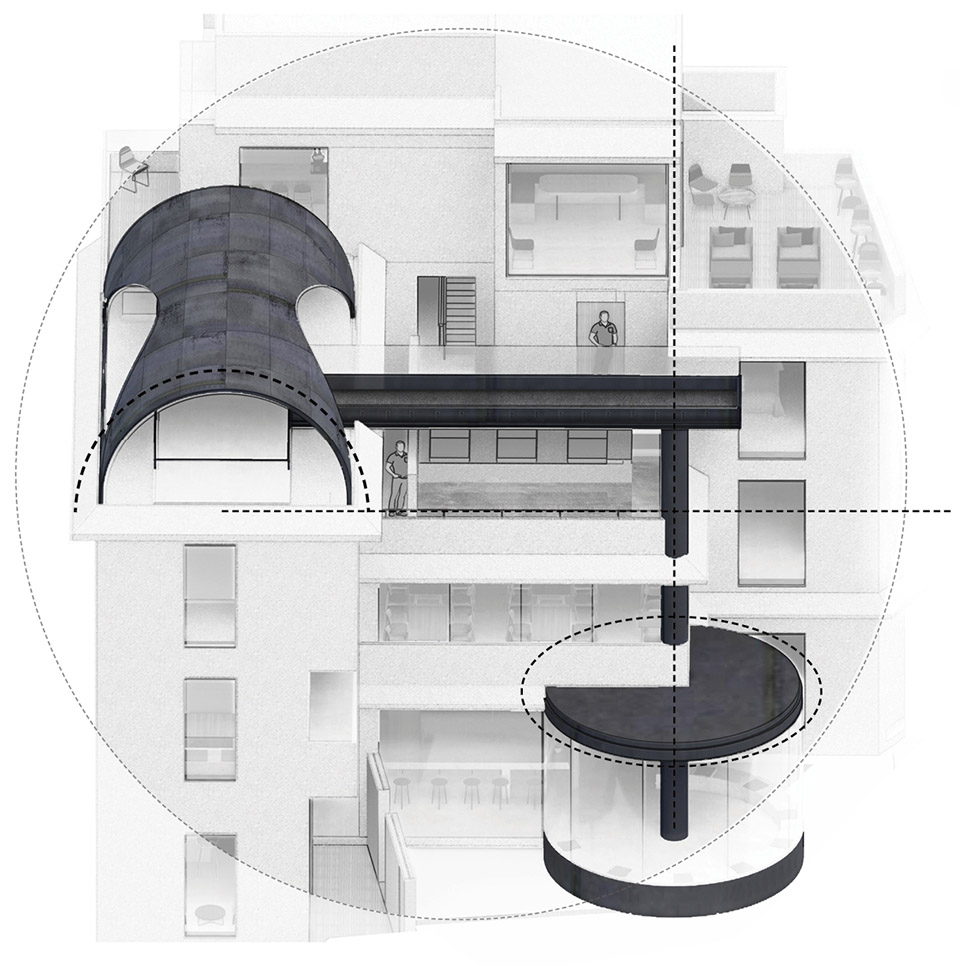
We chose to build an endless bridge in the fog. “Bridge” is a construction with a clear meaning: in space, it points to a bridge-like passing behavior; in narrative, it is often connected with “events” such as “mutual viewing” and “encounter”. Its stable and clear symbolic nature, together with the presence of the erratic landscape, creates a wonderful fantasy experience.
▼雾天桥景,the bridge in fog ©止建筑

▼雾天的桥,the endless bridge in the fog ©止建筑

▼雾天的平台,the platform in fog ©止建筑
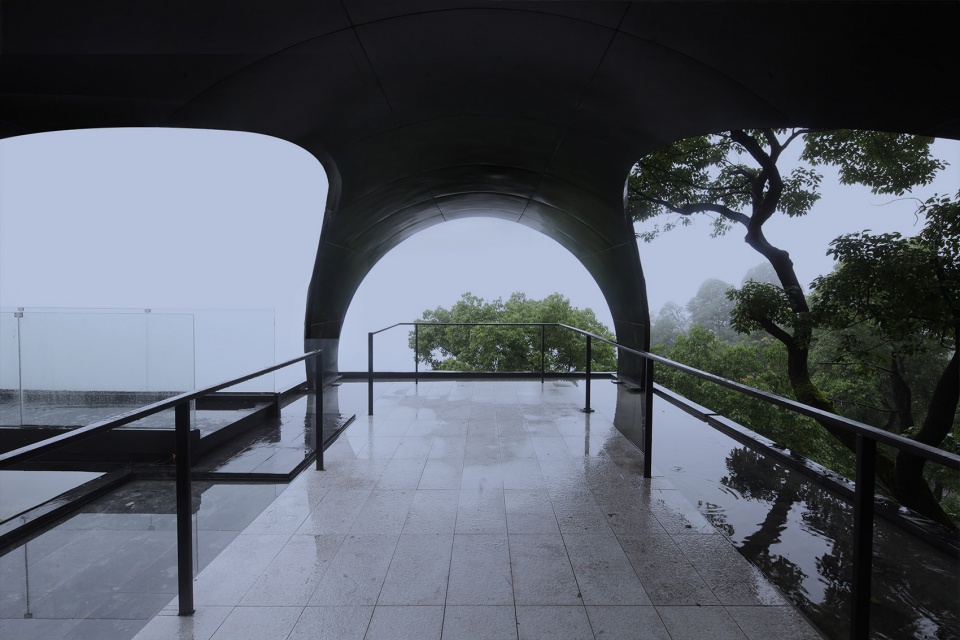
桥的平台顶棚采用了四面拱的几何原型,亦旨在强化其作为“物”的稳定性。其与桥,柱子,和首层加建圆柱体,形成了一个自恰的几何体系,以一个轻量化的姿态并置于原建筑的形体之上,主导了建筑整体的形式表情。
The platform roof of the bridge adopts the geometric prototype of the four-sided arch, which also aims to strengthen its presence. It forms a self-consistent geometric system with bridges, pillars, and cylinders on the first floor. It is placed on top of the original building in a lightweight posture, and dominates the overall outlook of the building.
▼屋顶平台与桥,the roof terrace and bridge ©此间建筑摄影

▼从四楼平台看桥,viewing the bridge from the fourth floor platform ©此间建筑摄影

▼屋顶平台与拱顶,the roof terrace and vault ©此间建筑摄影

桥最终也作为某种“标识”对原先孤立的露台空间进行了叙事性的连接:三楼北部露台初见,桥与桥上之人构成了一个戏剧性的前景;四楼东侧露台上桥,拱形画框和雾中弥散的桥梁达成了某种宗教式的崇高感;四楼西侧露台守望,平台与桥端之人相视而无法相遇。
The bridge finally acts as a kind of “sign” to connect the originally isolated terrace space in a narrative way: At first sight on the northern terrace of the third floor,the bridge and the people on the bridge form a dramatic foreground;On the east terrace of the fourth floor, the arched picture frame and the bridge diffused in the fog achieve a certain sense of religious sublime; On the west side of the fourth floor, the people on the platform and the people at the end of the bridge can see each other yet cannot meet.
▼从三楼平台看,viewing the bridge from the third floor platform ©此间建筑摄影

▼三楼平台,the third floor platform ©此间建筑摄影

▼从一楼入口看桥,
viewing the bridge from the ground floor entrance ©此间建筑摄影

记忆
MEMORY
“城市不会泄露自己的过去,只会把它像手纹一样藏起来,它被写在
街巷的角落,窗格的护栏,楼梯的扶手…每一道印记都是抓绕、锯锉、刻凿、猛击留下的痕迹。”
“The city doesn’t reveal its past, it just hides it like a handprint, it’s written in the corners of the streets, the guardrails of the panes, the handrails of the stairs… Every mark is a trace left by scratching, sawing, chiseling, and punching. ”
—— 卡尔维诺,Calvino
▼原建筑图解示意,analysis diagram of the original part of the house ©止建筑

原建筑内部空间秩序始于一种自下而上的野蛮生长,其在有限的的尺度内呈现了某种混沌而戏剧性的叙事感:首层不到200平方的面积里,并置着3个不同位置与形制的楼梯;内部充斥着各种始料未及的高差与不知通往何处的门洞;水洗石与饰面砖等室外材料会突然出现在室内,模糊了边界的感知。原建筑也由此成为某种记忆的载体,有着独立自洽的叙述结构。
The internal spatial order of the original building begins with a savage growth from the bottom up, which presents a chaotic and dramatic narrative within a limited scale: the first floor is less than 200 square meters, and there are three stairs with different positions and shapes; the interior is full of unexpected height differences and door openings that lead to nowhere; outdoor materials such as washed stone and veneer bricks suddenly appear indoors, blurring the perception of boundaries. The original building has thus become a carrier of memory, with an independent and self-consistent narrative structure.
▼原建筑细节,original state of interior ©止建筑
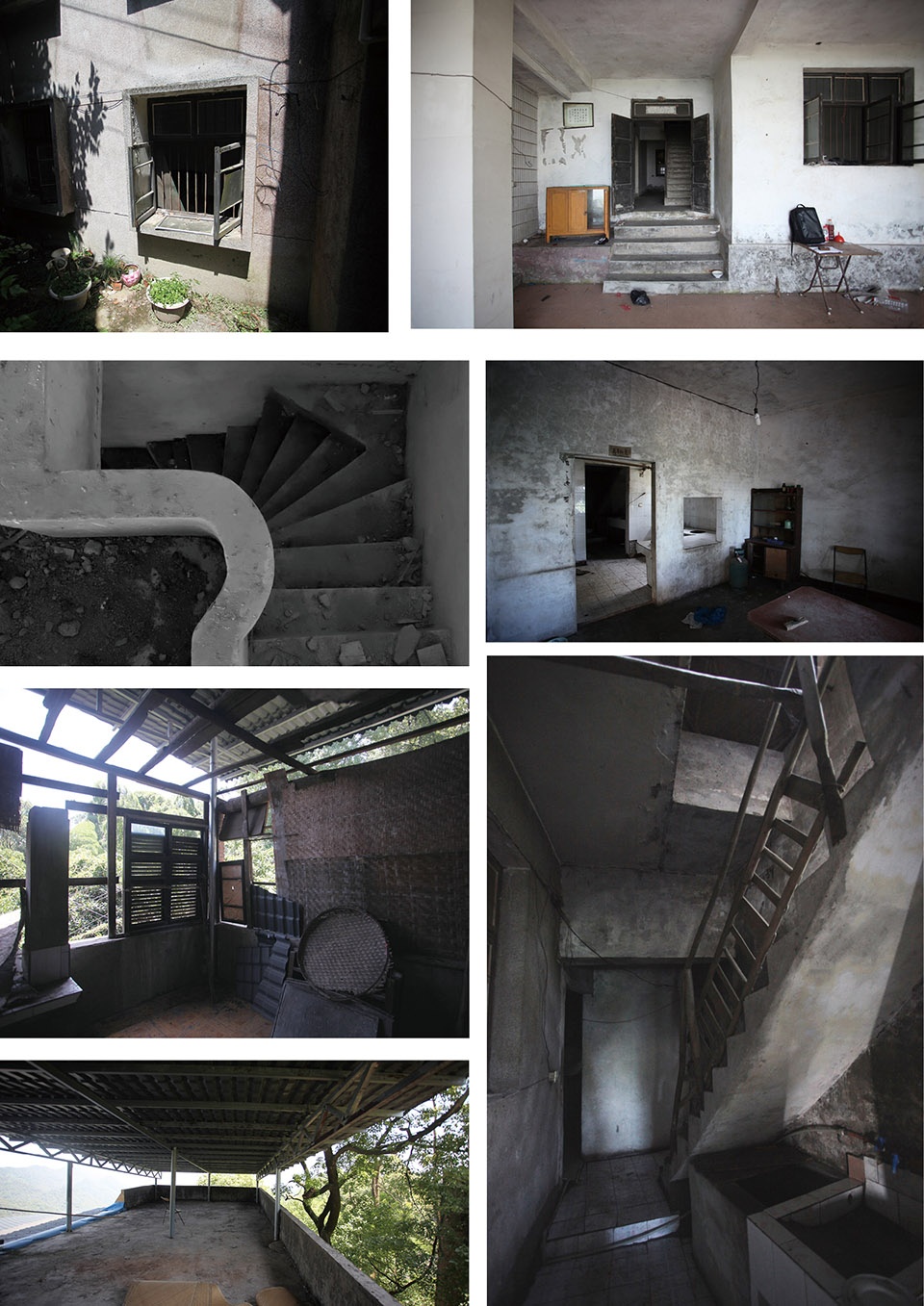
剪辑
EDITING
我们将建筑内部的整体性改造定义为“剪辑”,基于原有建筑的叙事结构与记忆节点,进行“梳理”“整合”与“调度”。
We define the overall renovation of interior as “editing”, and based on the narrative structure and memory nodes of the original building, we carry out methods such as “combing”, “integration” and “scheduling”.
▼一楼改造前后平面对比,ground floor plan before and after renovation ©止建筑

首层的开放院落被室内化并辅以水景反射远山,顾客在入口处需先进入西侧较为封闭的接待室,转折之后会直面扑面而来的山景;原建筑边缘围绕角柱做了一个圆形的空间的放大,将方形角柱变为一个向心性的中心柱,隐晦的暗示了其所支撑的作为体验高潮的顶楼构筑:原位于首层主入口的主门洞被封上,将住客往东面引导,西侧旋转楼梯则被按原状保留下来同时作为上二楼的快速通道。
The open courtyard on the first floor is indoorized and supplemented by water features to reflect the distant mountains. At the entrance, customers need to enter the relatively closed reception room,after which they will face the mountain. The enlargement of the circular space turns the square corner column into a centripetal central column, which implicitly hints at the top-floor structure: the main doorway originally located at the main entrance on the first floor is sealed, allowing the residents to Leading to the east, the spiral staircase on the west side is kept as it is and serves as a fast passage to the second floor.
▼一楼大厅看向室外,viewing exterior from the ground floor lobby ©此间建筑摄影

▼一楼画室看向室外,viewing exterior from the ground floor gallery ©此间建筑摄影

▼一楼画室看向大厅,viewing the lobby from gallery ©此间建筑摄影

东侧体块较为特殊,上下层8个房间中有6个为黑房间,一部形制特殊的老楼梯占据了区域的中心。为了回避黑房间的使用弊端,我们将“画室”功能置入其中,以一条明确的观展动线强化了原建筑中灵活的游走体验。“展厅”由人造光源所营造出的稳定和人工感与“遗址”(老楼梯)所呈现的粗野与原始亦形成了某种对仗。
The east side block is special, 6 of the 8 rooms are black, with an old staircase with a occupies the center of the area. In order to avoid the disadvantages of using the dark room, we put the “gallery” function in it, and emphasized the flexible walking experience in the original building with a clear viewing and moving line. The stability and artificiality created by the manmade light source in the “gallery” and the roughness and primitiveness presented by the “relics” (old stairs) also form a certain counterpoint
▼一楼画室,ground floor gallery ©此间建筑摄影

▼一楼画室看原址楼梯,viewing the original staircase from the gallery ©此间建筑摄影

▼原建筑楼梯区域,the original staircase ©此间建筑摄影

推手
PUSH HANDS
在单一空间改造操作上,我们借用了“推手”的概念,希望在把握空间原有形制结构的基础上,顺势而为。具体而言,我们总结了3种手法类型:留白,原址保留空间内重要的构建节点或强化突出窗外景观,其他部分以刷白整平为主;增补,基于原有空间的高差和洞口,做适量加减以适应人的行为尺度;置换,拆除部分临时性构筑,以更稳定的几何秩序构建提供锚定的空间体验。
▼改造推手图解,analysis diagram ©止建筑
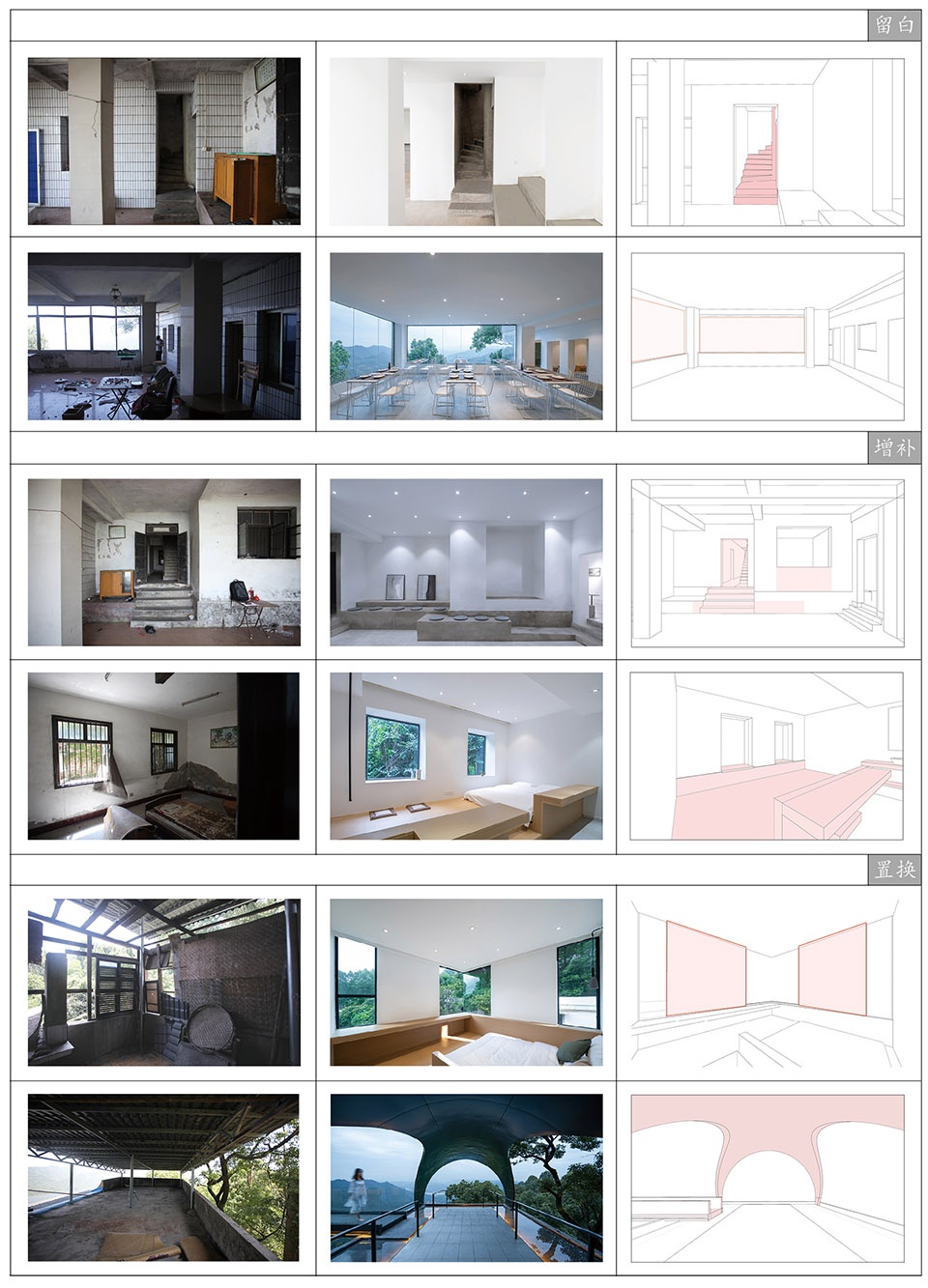
In the renovation of a independent space, we borrowed the concept of “push hands”, hoping to follow the trend on the basis of grasping the original shape and structure of the space. Specifically, we summarize 3 types of techniques: leave blank, retain important construction nodes in the original space or highlight the landscape outside the window, leaving other parts whitewashed and flattened; supplementary, based on the height difference and opening of the original space, Appropriate additions and subtractions are made to adapt to the scale of human behavior; replacement ,replace some temporary structures with a more stable geometric order to provide an anchored spatial experience .
▼增补改造后的一楼大厅,the ground floor lobby after renovation ©止建筑

▼二层餐厅与包间洞口,restaurant and private booth on the first floor ©此间建筑摄影

▼二楼餐厅的洞口,details of the restaurant on the first floor ©此间建筑摄影

洞口
HOLE
受限于成本控制,所有内部墙体的改造操作仅限于开凿一个80公分的门洞和去掉窗下墙。这使得公区和客房内部充满“洞口”,其作为媒介将流动的小空间串联起来,会在不经意间形成一些暗示性的对望关系。客房设计的核心亦是在处理各类洞口和床铺的对位关系。
▼房间与洞口,guest rooms and openings ©止建筑

▼洞口,openings ©止建筑

Restricted by budget, all interior wall renovation operations are limited to digging an 80-centimeter door opening and removing the lower wall of the window. This makes the interior of the public area and guest rooms full of “holes”, which as a medium connect the small flowing spaces in series, serving as a hint. The core of the guest room design is to deal with the counterpoint relationship between various openings and beds’ position.
▼置换改造后的客房,guest room after renovation ©此间建筑摄影

▼材料的对比,contrast between the material ©此间建筑摄影

▼浴室,bathroom ©此间建筑摄影

舞台
STAGE
建筑正式运营后,我很乐于在各类平台上刷看来访者的体验视频。有在桥头作画的少女,有在屋顶压腿的芭蕾舞团,亦有在桥上喜结连理的眷侣。所有的这些人,以一种微妙的方式与素不相识的“我”完成了某种连接。我并不知道他们如何评价这个设计,但我确信他们都曾由衷地欣赏着那个在“舞台”上表演着的自己。
After the official operation of the building, I enjoy watching the experience videos of visitors on various platforms. There are young girls painting on the bridge, the ballet troupe pressing their legs on the roof, and the couples tying the knot on the bridge. All of these people, in a subtle way, made a connection with the “I” whom they had never met. I don’t know how they rated the design, but I’m sure they all genuinely admired themselves on that “stage”.
▼楼梯间细部,details of the staircase ©此间建筑摄影/止建筑

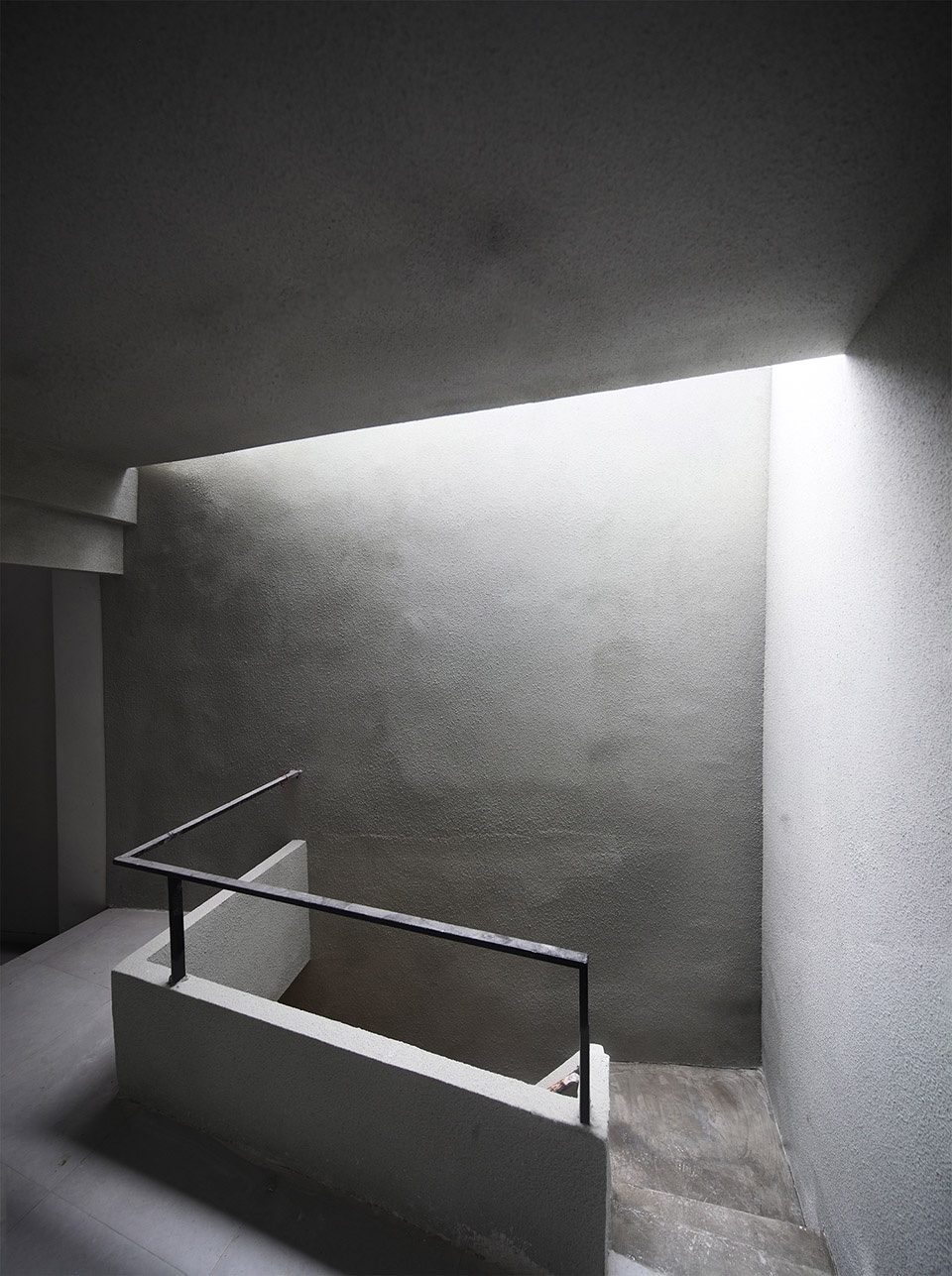
▼一层平面图,1f plan ©止建筑
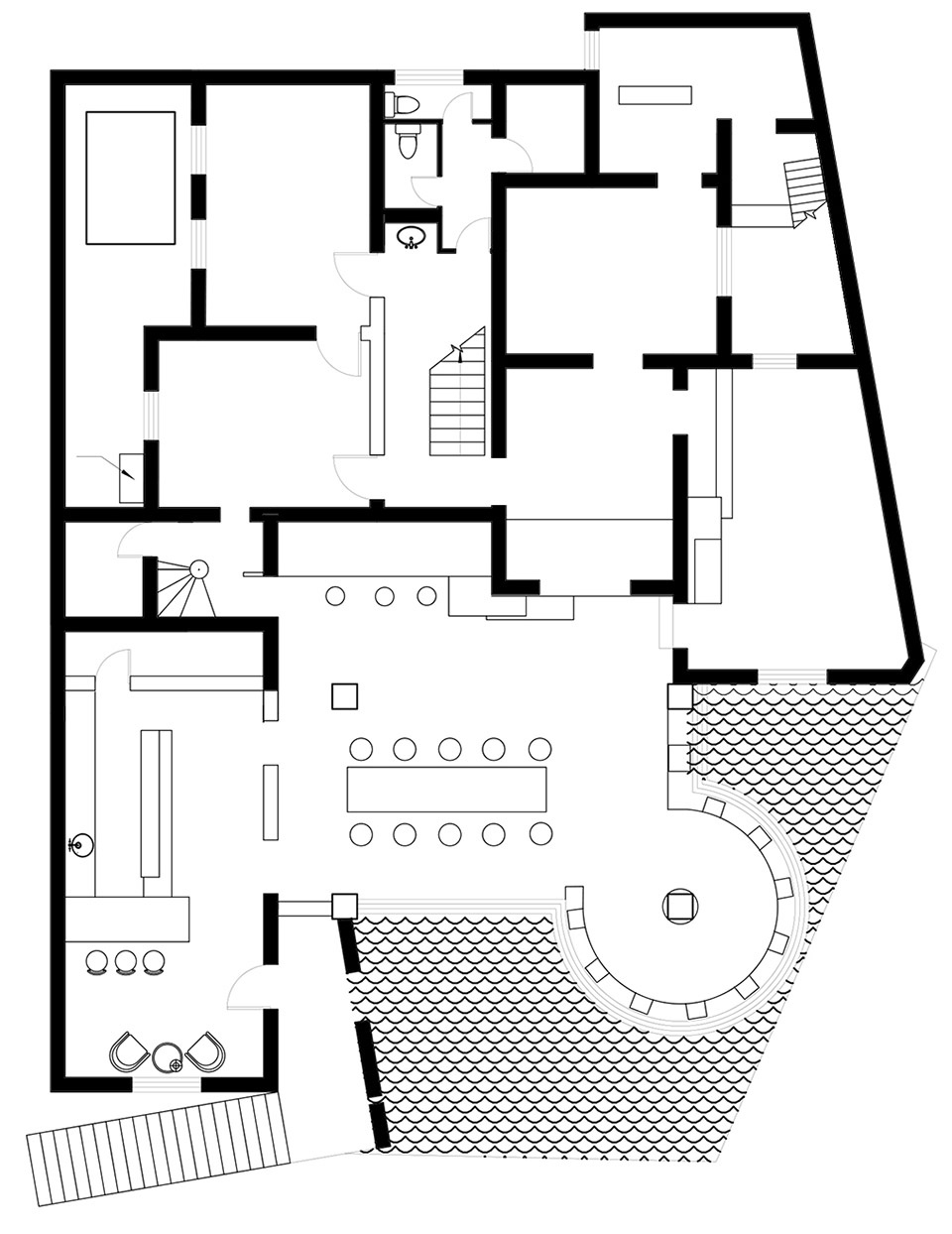
▼二层平面图,2f plan ©止建筑

▼三层平面图,3f plan ©止建筑

▼四层平面图,4f plan ©止建筑
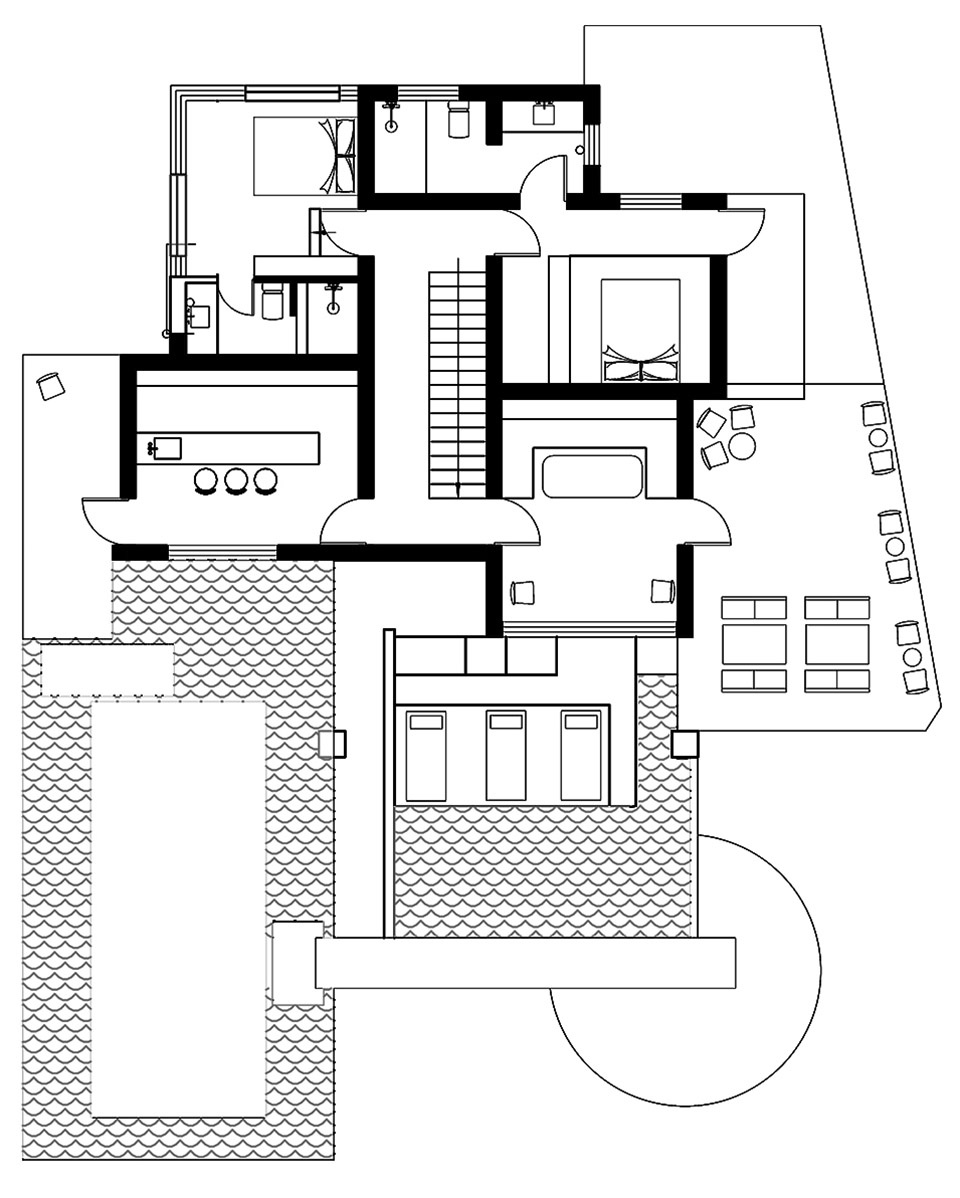
▼正立面图,front elevation ©止建筑

项目名称:桥舍
项目类型:民宿 画室
设计方:武汉止建筑
项目设计:2019
完成年份:2020
设计团队: 余凯 贵溥健 王志峥 钱曼 刘晨阳 肖磊 刘沛桐 迟悦 寇宗捷 黄尤佳 臻真 小筑
设计咨询顾问:范久江 胡兴 刘常明
项目地址:重庆南山
建筑面积:910㎡
摄影版权:此间建筑摄影(赵奕龙 万勇波) 止建筑
客户:城外有星光文旅集团有限公司










